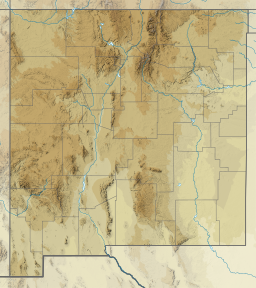Zuni Salt Lake
| Zuni Salt Lake | |
|---|---|
 c. 2000 | |
 Zuni Salt Lake | |
| Location | Catron County, New Mexico, United States |
| Coordinates | 34°27.0′N 108°46.1′W / 34.4500°N 108.7683°WCoordinates: 34°27.0′N 108°46.1′W / 34.4500°N 108.7683°W |
| Type | Maar |
| Primary outflows | Evaporation |
| Basin countries | United States |
| Surface elevation | 6,224 ft (1,897 m)[1] |
| References | [1] |
Zuni Salt Lake, also Zuñi Salt Lake is a rare high desert lake, and a classic maar. It is located in Catron County, about 60 miles south of the Zuni Pueblo, New Mexico, USA. Zuñi Salt Lake is extremely shallow, with a depth of only four feet in the wet season. During the dry season, much of the water evaporates leaving behind salt flats. It was listed on the National Register of Historic Places in 1999.[2] It is part of the Red Hill volcanic field.[3]
History[]
For centuries, the Pueblo people of the Southwest, including the Zuni, Acoma, Laguna, Hopi and Taos pueblos, have made annual pilgrimages to Zuñi Salt Lake to harvest salt, for both culinary and ceremonial purposes. Ancient roadways radiate out from the lake to the various pueblos and ancient pueblo sites, such as Chaco. The lake itself is considered sacred, home of the Salt Mother deity, known to the Zuñi as Ma'l Okyattsik'i. Also known as Las Salinas to early Hispanic settlers in the area.
Famous Apache chief Geronimo, in Geronimo's Story of His Life reported the following about the lake: "We obtained our salt from a little lake in the Gila Mountains.... When visiting this lake our people were not allowed to even kill game or attack an enemy. All creatures were free to go and come without molestation."
The Zuni Salt Lake was not part of the Zuñi reservation originally recognized by the U.S. government, but the U.S. returned the lake itself, and 5,000 acres (2,000 ha; 20 km2) surrounding it, to Zuni control in 1985.
Controversy[]
From 1994 to 2003, there was a proposal to develop a coal mine near the Zuni Salt Lake.[4][5] It would have involved extraction of water from the aquifer below the lake as well as construction between the lake and the Pueblo of Zuñi.[6][7] The proposal was withdrawn after several lawsuits, and is regarded as an important exercise of native rights in the United States.
References[]
- ^ Jump up to: a b "Zuni Salt Lake". cLocations. Retrieved July 24, 2007.
- ^ (nd) National Register of Historic Places – Catron County, New Mexico. Retrieved 6/16/07.
- ^ Crumpler, L. S., and Lucas, S. G. (2001). "Volcanoes of New Mexico: An Abbreviated Guide For Non-Specialists". Volcanology in New Mexico. New Mexico Museum of Natural History and Science Bulletin. 18: 5–15. Retrieved May 4, 2010.CS1 maint: uses authors parameter (link)
- ^ LaDuke, Winona (2002) "The Salt Woman and the Coal Mine" Sierra Magazine
- ^ Legard, Carol (August 15, 2003) "New Mexico and Arizona: Construction of Fence Lake Mine" U.S. Advisory Council on Historic Preservation
- ^ Zuni Salt Lake Earth Island Institute (2004)
- ^ Testimony of Malcolm B. Bowekaty, Governor of the Zuni Tribe before the United States Senate, Committee on Indian Affairs, July 17, 2002, Washington, D.C.
- Landforms of Catron County, New Mexico
- Volcanic crater lakes
- Endorheic lakes of the United States
- Lakes of New Mexico
- Bodies of water of Catron County, New Mexico
- Religious places of the indigenous peoples of North America
- Native American history of New Mexico
- Sacred lakes
- Saline lakes of the United States
- Maars of New Mexico
- Natural features on the National Register of Historic Places in New Mexico
- National Register of Historic Places in Catron County, New Mexico

